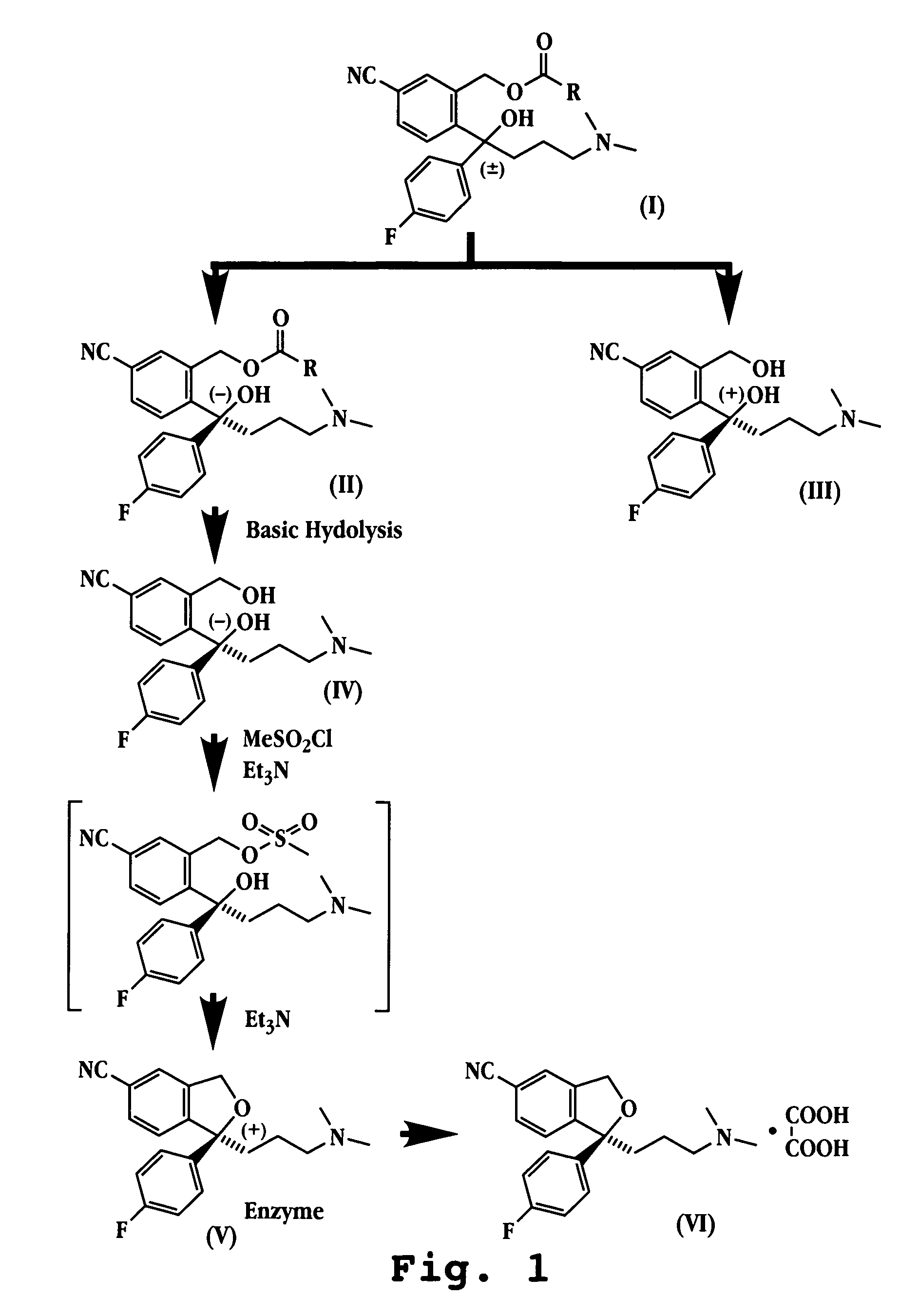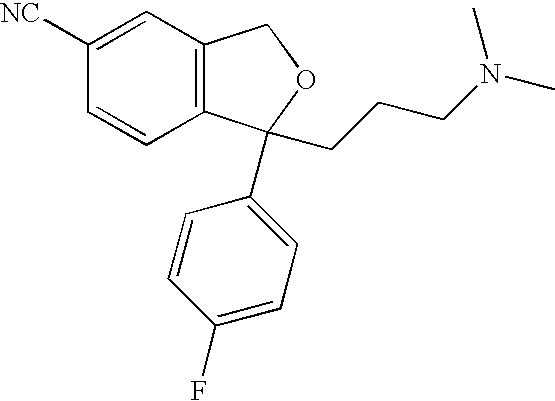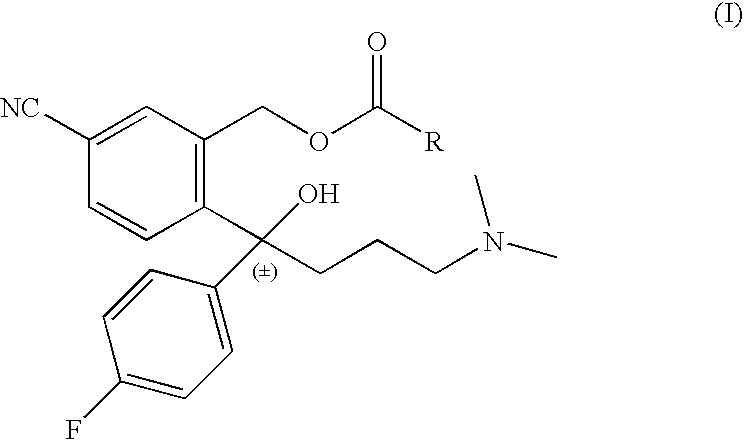Chemo-enzymatic process for the preparation of escitalopram
a technology of escitalopram and escitalopram, which is applied in the field of escitalopram chemoenzymatic process, can solve the problems of limiting the scalability of the process and the reaction yield
- Summary
- Abstract
- Description
- Claims
- Application Information
AI Technical Summary
Benefits of technology
Problems solved by technology
Method used
Image
Examples
example 1
Synthesis of 4-(4-dimethylamino)-1-(4′-fluorophenyl)-1-(hydroxybutyl)-3-(acetoxymethyl)benzonitrile
[0037]58.7 g of 4-(4-dimethylamino)-1-(4′-fluorophenyl)-1-(hydroxybutyl)-3-(hydroxymethyl)benzonitrile were placed in a 4-neck flask in a water bath at between 30 and 35° C., preferably 35° C., and 210 ml of acetyl chloride (17 moles per mole of starting product) were added dropwise into this medium. The admixture was left under agitation for 5 minutes, transferred to a 1-neck flask and evaporated at reduced pressure. 79.02 g of 4-(4-dimethylamino)-1-(4′-fluorophenyl)-1-(hydroxybutyl)-3-(acetoxymethyl)benzonitrile in the form of an orange oily residue was obtained. 1H NMR (DMSO-d6) δ 7.9 (d, 1H ), 7.8 (d, 1H), 7.75 (s, 1H), 7.2 (d, 2H), 7.1 (d, 2H), 6.2 (s, 1H), 5.2 ( d, 1H), 4.8 (d, 1H), 3.0 (m, 2H), 2.60 (m, 6H), 2.3 (s, 2H), 1.9 ( s, 3H), 1.7 (m, 1H), 1.4 ( m, 1H).
example 2
Enzymatic Resolution of 4-(4-dimethylamino)-1-(4′-fluorophenyl)-1-(hydroxybutyl)-3-(acetoxymethyl)benzonitrile
[0038]10 g of 4-(4-dimethylamino)-1-(4′-fluorophenyl)-1-(hydroxybutyl)-3-(acetoxymethyl)benzonitrile (250 mM) were dissolved in 52 ml of MeOH, to which 52 ml of a 25 mM, pH8 monobasic potassium phosphate buffer were subsequently added.
[0039]The pH was then brought to 6 by carrying out suitable modifications with 2N HCl and compensating for the volume of HCl added with the same amount in ml of MeOH in order not to change the composition of the solution. The temperature of the solution was controlled so as to be in the range of between 20 and 25° C.
[0040]Finally, approximately 75 units of esterase enzyme derivative was added to the solution. The esterase enzyme derivative was obtained from crude lipase extract from Aspergillus niger and immobilized on epoxy resin, such as Eupergit C, according to conventional processes.
[0041]The reaction was carried out using an automatic titr...
example 3
Synthesis of (−)4-(4-dimethylamino)-1-(4′-fluorophenyl)-1-(hydroxybutyl)-3-(hydroxymethyl)benzonitrile
[0048]The crude product isolated by the preceding reaction (8 g) was dissolved with diethyl ether (approximately 40 ml). A minimum quantity of ethyl acetate (0.1 ml) was added and the mixture was heated gently. Precipitation of a solid was obtained by cooling. The filtrate was subjected to a second crystallization operation and, after cooling to from 0-4° C., precipitation of solely (−)4-(4-dimethylamino)-1-(4′-fluorophenyl)-1-(hydroxybutyl)-3-(acetoxymethyl)-benzonitrile as a white solid (2.2 g) with a purity of 98% and with 99.8% e.e., [α]D=−39.87 / −40.00 was obtained. The solid obtained was subsequently dissolved in 175 ml of 30% NH3 and in 100 ml of MeOH, the solution was left under agitation for approximately 4 hours and subsequently evaporated to produce 1.9 g of (−)4-(4-dimethylamino)-1-(4′-fluorophenyl)-1-(hydroxybutyl)-3-(hydroxymethyl)benzonitrile.
PUM
 Login to View More
Login to View More Abstract
Description
Claims
Application Information
 Login to View More
Login to View More - R&D
- Intellectual Property
- Life Sciences
- Materials
- Tech Scout
- Unparalleled Data Quality
- Higher Quality Content
- 60% Fewer Hallucinations
Browse by: Latest US Patents, China's latest patents, Technical Efficacy Thesaurus, Application Domain, Technology Topic, Popular Technical Reports.
© 2025 PatSnap. All rights reserved.Legal|Privacy policy|Modern Slavery Act Transparency Statement|Sitemap|About US| Contact US: help@patsnap.com



